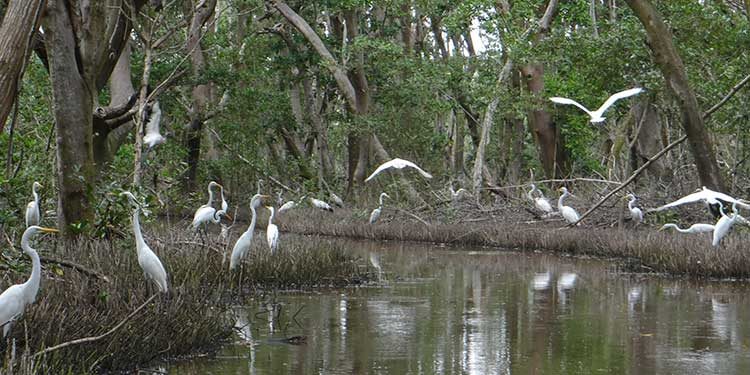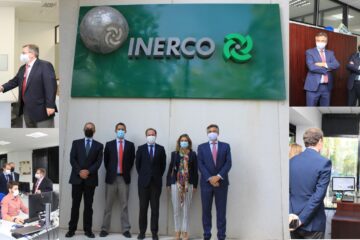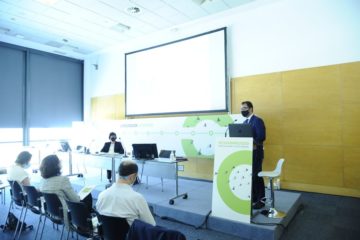Experts analyze the role of the Environmental Assessment System in Colombia in a webinar organized by INERCO

INERCO held a webinar focused on the analysis and assessment of the Environmental Assessment system in Colombia, a joint reflection for which a wide range of top-level panelists have been counted on a key issue for the execution of projects.
The webinar moderated by Gabriel Medina, Technical Manager of INERCO Colombia, had the participation of Luis Gilberto Murillo, Former Minister of the Environment of Colombia (2016 – 2018); Eduardo Uribe, former Vice Minister of the Environment of Colombia (1994); Rodrigo Jiliberto, Economist and International Consultant on Strategic Analysis of the Environment and Public Policies; Esther Valdivia, Director of the Environment at INERCO, and Roberto Cárdenas, Director of the Area of Environmental Studies at INERCO Colombia.
For Gabriel Medina, the environmental licensing system defined after the enactment of Law 99 of 1993 (the result of the general framework defined by the 1991 constitution) has become increasingly complex and in particular the preparation of the Environmental Impact Study (EIA), “despite the improvement processes it has undergone, there is a lack of structure in the environmental regulatory development in Colombia, with an alignment of national and regional functions.”
Luis Gilberto Murillo highlighted Colombia as a pioneer country in environmental aspects at the governmental level, from the first steps in 1968, “with the creation of the National Institute of Renewable Natural Resources and the Environment (INDERENA)” to the institutional reforms of 2010 and 2011, “which led to the creation of the National Environmental Licensing Authority (ANLA), other tools and a series of regulations. Here the environmental management of the different sectors takes force ”.
In this sense, the former Minister of the Environment of Colombia affirms that the current licensing system has come hand in hand “by demand that part of the policy, especially between companies, citizens and the institutional response has been very reactive, it has not been proactively, we have not been able to anticipate future challenges and that is a pending that affects the system ”.
Eduardo Uribe, recalled the environmental wave that Colombia lived in the 80s, “from which the 1991 Constitution drew, which gathered that international sentiment about the importance of the environment as a strategy for the generation of social well-being.”
“In these years, there has been progress. Two steps forward, one step back… but the change and progress has been immense. Thanks to the criticism it improves, but the change has been galactic in terms of building a society that is more respectful of the environment and communities, the least favored and vulnerable, ”says the former Vice Minister of the Environment.
Rodrigo Jiliberto contributed Chile’s point of view in this licensing process, which did not exist until the arrival of Democracy in the 1990s, but with important advances since then “with an international context that made Chile include it in its day within its democratization process.
Esther Valdivia, highlighted the European vision of the Environment, with special emphasis from the 1985 European Directive on Environmental Impact Assessment of Projects and its continuous improvements.
Roberto Cárdenas, broke down the evolution and continuous learning process in Colombia in this environmental chapter, “an exercise in constructive and participatory dialogue between all the actors, which allows us to see the sensitivities and concerns of each agent.”
Current challenges regarding Environmental Assessment Studies
The current Environmental Assessment system in Colombia faces great challenges according to all the panelists. As Eduardo Uribe acknowledges, it is important to seek a global and comprehensive view of the studies, “because we cannot approve EIAs independently, but they must lead to sustainable regional developments”.
Along the same lines, Luis Gilberto Murillo highlighted the importance of knowing what development model to follow, “the emphasis must be on understanding the role that the EIA really plays and that, in addition to that, the country advances in a discussion in its roadmap and discussion, but mechanisms such as Strategic Environmental Assessment must be given tools”.
Furthermore, Murillo evidenced that, in his opinion, it is a latent current risk: “We are at risk in which technical decisions are affected by the same fear to justify political positions. In this new stage of more citizen participation, it is the fundamental problem that must be assumed both in Colombia and elsewhere”.
Rodrigo Jiliberto was more critical, with special interest in providing greater credibility to this environmental institutional mechanism. Thus, he advocated a structural change that involves society more when it comes to knowing which project is valid: “We must institutionalize deliberation with a process of social construction of risk. We have the construction of technical risk, but it must be comprehensive and society must contribute its vision so that it is also taken into account”.
Esther Valdivia spoke along the same lines, pointing out the need for technical support “very well documented for projects of a more social nature.”
The role of the Environmental Authority in Colombia
Eduardo Uribe also pointed to the need for the Colombian Administration to take a further step in the environmental chapter: “Because for environmental development to be high, the sectoral ministries should have the responsibility of ensuring the good performance of the projects, not of the administrative processing exclusively”. “It is not only about setting up an office that processes EIA, but that office must guarantee high environmental performance and not just leave it as a space to obtain licenses.”
Rodrigo Jiliberto spoke along the same lines, pointing to the need for a strategic sector policy. “When that is clear, it will be easier to tackle projects, but sustainability policies are needed, a more strategic view of sustainability in each sector.”
Roberto Cárdenas contributed his expert vision as Environmental Manager in INERCO Colombia and highlighted the value of local agents, “with a very valuable local knowledge and who provide many sensitive elements for decision-making. It is very productive to work with them to know the focus of the study and the procedures that are carried out, but sometimes they are marginalized from the evaluation processes and they do not feel that they are listened to when they express their closest and most direct concepts”.
Proposals for improvement for Environmental Licensing in Colombia
The experts participating in the INERCO webinar on the analysis and assessment of the Environmental Assessment system in Colombia pointed to the need to make this process more deliberative, political, democratic and simple from a technical point of view.
Rodrigo Jiliberto considers that the path is clear: “Either you walk that way or it ends up stopped in the courts. And it cannot be that each project ends up in court, companies are very alone in front of the world and the worst way is to make the process more technical”.
Likewise, he pointed to the role of companies in this process, “which are beginning to do things well, to understand the territories and their circumstances. And you must answer this question: what do I contribute to this region? Because they are seeing that they get into political and judicial problems if they don’t”.
For Luis Gilberto Murillo, the internal deliberative aspect of the Government is a great challenge, “because companies have become accustomed to having a special deliberative process for their projects and many have seen this system as a mere procedure and it is not like that.”
In his experience, the hinge is ANLA, “but much of what it must do does not depend on them, but on the economic conditions and resources it has,” while also pointing to the need to have supportive environmental jurisdiction.
Eduardo Uribe, for his part, points to the need for greater commitment from governments to maintain environmental policy. “Policies are nice but they have to provide strong incentives for institutions to adopt and enforce them.”
Esther Valdivia pointed to the need to streamline procedures in the resolution of the EIA projects that are presented, as well as the value of a Registry of EIA writers, “as there are in Peru and other countries, which is a basis for taking as a starting point, although we don’t always talk about quality”.
For his part, Roberto Cárdenas pointed to a key element in this process: the generation of trust among all the agents involved in the EIA. “The communities, the companies, the Authority … everyone mistrusts the EIA professionals and there is a great exercise of building base trust and for that it is necessary that everyone knows the processes in depth, that there is transparency”.
Gabriel Medina acknowledged that the EIA in Colombia has had improvements throughout these years, “but we must understand its role and not believe that this tool solves everything.” In this sense, he pointed to the commitment of the regulated sectors early to incorporate the environment in the decisions they make, as well as to make the processes more deliberative and political decision as such.






